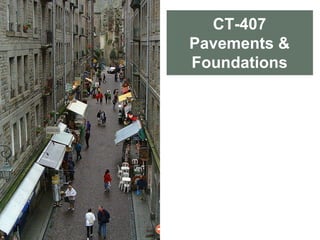
Determining equivalent single wheel load.(ESWL)
- 2. DETERMINING EQUIVALENT SINGLE-WHEEL LOADS (ESWL) • An equivalent single wheel (ESWL) is defined as the load on a single tire that will cause an equal magnitude of a preselected parameter (stress, strain, deflection) at a given location within a specific pavement system to that resulting from a multiple-wheel load at the same location within the pavement structure. • Depending upon the procedure selected, either the tire pressure or contact area of the ESWL may be equal to that of one tire of the multiple- gear assembly.
- 3. DETERMINING EQUIVALENT SINGLE-AXLE LOAD (ESAL) • Equivalent Single Axle Load (ESAL) is the effect on pavement performance of any combination of axle loads of varying magnitude equated to the number of standard single-axle loads that are required to produce an equivalent effect.
- 4. ESWL & ESAL • Normally, in ESWL design approach, only a “critical” or “design” vehicle is used (e.g. heaviest or most damaging aircraft) and the damage effects of the other vehicle types are ignored. This procedure is largely applied to airports. • For highway ESAL design approach is used as the damage is related to the number of load repetition.
- 5. DETERMINING EQUIVALENT SINGLE-WHEEL LOADS (ESWL) • Several parameters have been used in pavement analysis to define the method of evaluating the ESWL. In general, these parameters fall into two categories: • (a) theoretically calculated or experimentally derived stress, strain, or deflection. • (b) pavement distress parameters such as cracking, serviceability level, or equal failure conditions.
- 6. FLEXIBLE PAVEMENT, EQUAL STRESS ESWL
- 7. FLEXIBLE PAVEMENT, EQUAL STRESS ESWL Figure illustrates the concept behind this approach. The total load of the dual tire assembly is Pd, with Sd being the center to center spacing and d being the clear distance between tire edges (d = Sd – 2ac). Because of the approximate zone of the stress bulb, it is assumed that for a pavement thickness t, less than or equal to d/2, no stress overlap occurs. Thus, the stress at these depths is due to that of only one wheel of the dual.
- 8. FLEXIBLE PAVEMENT, EQUAL STRESS ESWL Likewise, at a depth of approximately 2Sd, the effect of stress overlap is such that it is equivalent to the stress caused by a single-wheel load of Pd. It is further assumed that the wheel load acting on the intermediate depths between d/2 and Sd is linear when plotted on a log load versus log thickness diagram. Using this relationship, the ESWL, as a function of thickness, can be found directly from the diagram. For tandem gears, after the ESWL for the dual portion of the gear is found at a given depth, the procedure is repeated between the tandem distance.
- 9. RIGID PAVEMENT ESWL The use of maximum tensile concrete stress is universally recognized as the salient distress parameter by all design methods, even though differences between methods are present as to where (edge, center etc.) the stress is computed.
- 10. RIGID PAVEMENT ESWL LCN (LOAD CLASSIFICATION NUMBER) SYSTEM: One such design method using the ESWL is the Load Classification Number (LCN) system used in the United Kingdom.
- 11. RIGID PAVEMENT ESWL LCN (LOAD CLASSIFICATION NUMBER) SYSTEM:
- 12. RIGID PAVEMENT ESWL LCN (LOAD CLASSIFICATION NUMBER) SYSTEM:
- 13. RIGID PAVEMENT ESWL FAA METHOD: In contrast to LCN procedure, which assumes no dependence of the ESWL upon the pavement thickness or subgrade reaction, the FAA has used an ESWL analysis that takes these factors into account.
- 14. RIGID PAVEMENT ESWL FAA METHOD:
- 15. RIGID PAVEMENT ESWL FAA METHOD:
- 17. DETERMINING EQUIVALENT SINGLE-AXLE LOAD (ESAL) • Equivalent Single Axle Load (ESAL) is the effect on pavement performance of any combination of axle loads of varying magnitude equated to the number of standard single-axle loads that are required to produce an equivalent effect.
- 18. DETERMINING EQUIVALENT SINGLE-AXLE LOAD (ESAL) Notice that cars are insignificant and thus usually ignored in pavement design. 1.35 1.85 5.11 0.100.0007 0 1 2 3 4 5 6 Car Delivery Truck Loaded 18-Wheeler Loaded 40' Bus Loaded 60' Articulated Bus ESALsperVehicle